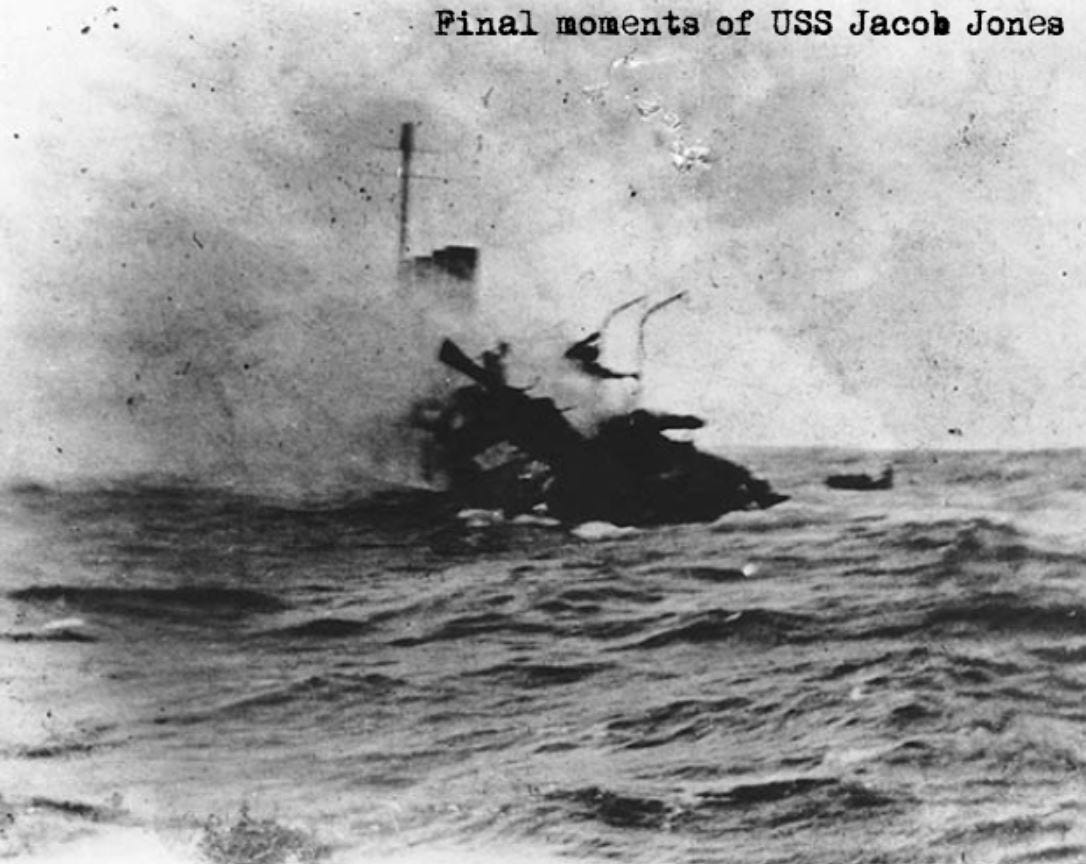TDIH: USS Jacob Jones torpedoed
The commander of the German U-boat radioed the location of the shipwreck to a nearby American base. In some ways, war used to be fought with a bit more honor and civility, didn’t it?
On this day in 1917, the destroyer USS Jacob Jones is torpedoed as she travels near the Isles of Scilly. Jacob Jones would be the first American destroyer lost to an enemy submarine during World War I.
Jacob Jones left for Europe almost as soon as the United States declared war on Germany in April 1917. Its job? Escort ship convoys and rescue the crews of downed vessels. During the summer of 1917, hundreds of survivors from at least two torpedoed British steamships and one British cruiser owed their lives to the rescue operations of Jacob Jones and her crew.
Unfortunately, the rescuers were about to need rescuing themselves.
On December 6, Jacob Jones left Brest, France. She’d just completed escorting a convoy and was now on a return course back to Queenstown, Ireland. By mid-afternoon, she was about 20 miles east of England.
Unfortunately, so was a German submarine.
“About 4:20 p.m.,” Lt. Commander David Bagley later wrote, “I was in the chart house with Lieutenant Norman Scott when I heard the shout, ‘Torpedo!’ As we immediately scrambled up to the bridge, I could see the torpedo about 800 yards distant. It was alternately broaching and submerging—and racing to strike us amidships.”
Attempts to maneuver away were useless. The torpedo was too close. It struck Jacob Jones on the starboard side, about three feet below the water line.
The electricity went out immediately, making it impossible to send a distress signal. The crew rushed to launch rafts and boats. The ship was sinking too fast! Men began jumping into the water.
Bagley jumped into the water himself, at the very last minute. “I turned and watched the last few seconds of the Jacob Jones, as the gallant vessel went down by the stern,” he later reported. “Suddenly, as her bow raised to a vertical position, the live depth charges went off. The force of the explosion was tremendous—killing a number of men and stunning many others—myself included.”
Jacob Jones had sunk in only eight minutes. More than 60 men went down with the ship. Several dozen survivors floated nearby on rafts, boats, and debris. You can imagine that it was pretty cold at this time of year.
In an odd twist, the commander of the German U-boat came to the surface and took aboard two of the injured survivors. He also radioed the location of the shipwreck to a nearby American base. He requested the courtesy of an hour to depart the location, in return for his good deed.
In some ways, war used to be fought with a bit more honor and civility, didn’t it?
Of course, the Americans floating in the water had no idea that help was on the way. Most of the survivors were on simple rafts, but two officers were able to leave in a motor-dory. (The motor wasn’t working, but four strong men helped man the oars.) The departing men hoped to find help in the Scilly Isles.
Fortunately, the crew of Jacob Jones was found before that motor dory ever arrived at its destination. The last survivor was pulled from the water on December 7 at 8:30.
Jacob Jones would end up being the only destroyer lost during World War I.
Sources can always be found on my website, here.





Wow! Another untold tidbit of history gifted to us by Tara! Thank you, Tara for memorializing the crew and vessel of the USS Jacob Jones!
I have also read of the civility of WWI Aviators on both sides paying one another respect. I have always suspected, at least in part, it was born of their being yards apart in open cockpits when they were dog fighting.